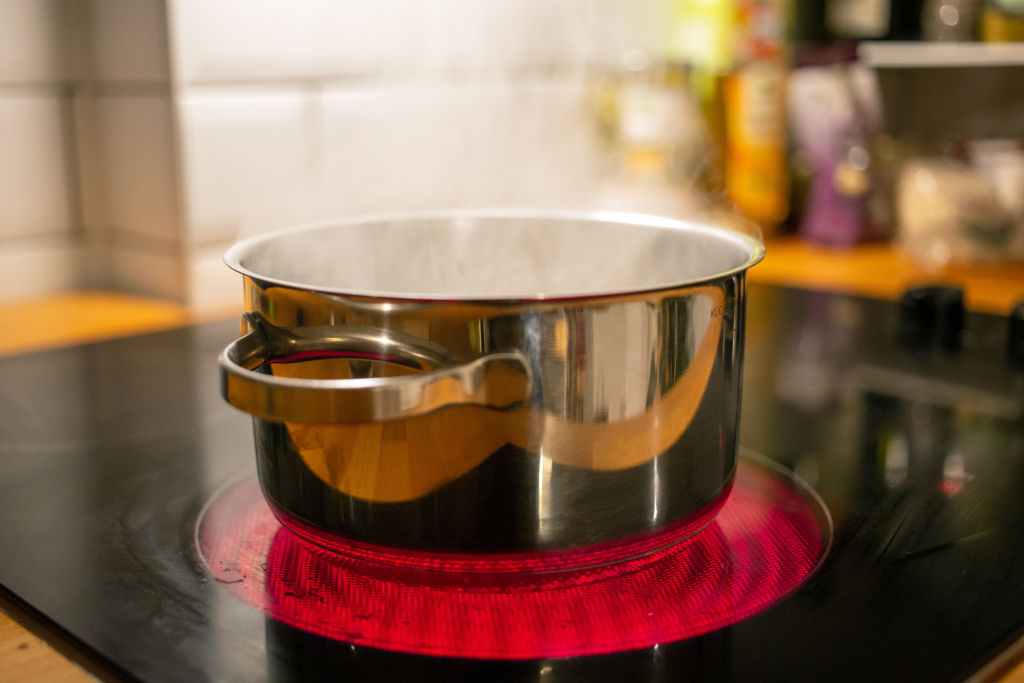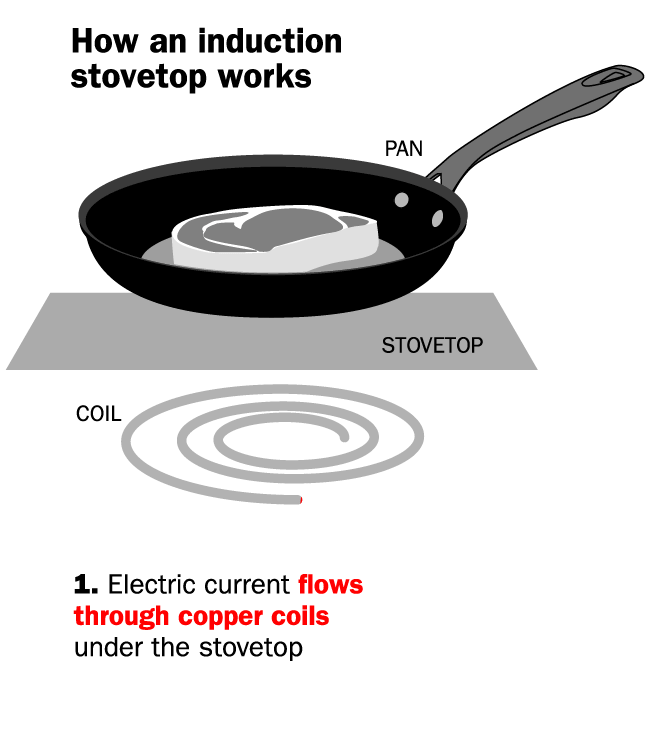
Gas stoves are associated with a certain allure: an image of prestigious chefs cooking in sought-after, high-end kitchens over an open flame. At the same time, electric stoves and their dated coils have been eschewed by many at-home culinary enthusiasts. But recently, that wisdom is being flipped upside down as the world gets a fuller understanding of the harmful health and climate impacts tied to our love of gas stoves.
A startling study published in January by Stanford University found that natural gas stoves—which more than a third of American homes use—may emit concerning levels of indoor air pollution, and could play a larger role in driving climate change than previously believed. Even when they weren’t being used, natural gas stoves were shown to release methane, a potent greenhouse gas, and other harmful pollutants—including formaldehyde, carbon monoxide, and nitrogen dioxide—through leaks and in the service line.
The findings beg a much larger question of whether households around the world should move to potentially safer, and more efficient, electric induction stoves.
Methane leaks found in American kitchens
Historically, residential homes and buildings have been a blind spot when it comes to methane emissions. Very few studies have tried to measure how much methane is released by living in our homes and working in buildings; one study suggests we may be undercounting this impact in cities. On top of this, the fossil fuel industry has worked hard to turn gas stoves into one of America’s most loved appliances.
Stanford earth system sciences professor Rob Jackson and his team at the Stanford Woods Institute for the Environment are helping change this understanding with their January gas stove study—the first to analyze this issue. Publishing their work in the peer-reviewed journal Environmental Science & Technology, the team measured methane and nitrogen oxides released in 53 California homes during various phases of the cooking process. In total, 18 brands of gas cooktops and stoves between three and 30 years old were analyzed.
They estimate that the methane leaking from natural gas stoves in the U.S. is equal to the emissions released by half-a-million gasoline-powered cars every year. Just using one gas stove for a year emits on average 649 grams of methane—equivalent to the number of emissions released from driving 40 miles. In addition to contributing to climate change, these pollutants can trigger concerning health effects, including respiratory diseases like asthma, and reduced cognitive performance, both of which children are particularly vulnerable to. Tiny particles of particulate matter released from the gas can also penetrate deep in the lungs and, when exposed in the short term, can cause irritation not just in the lungs but also the eyes, nose, and throat.
Methane is not only emitted when a stovetop is in use, but also when it is turned off. In fact, more than three-quarters of all the methane emissions released by the stoves happened when they were off, the study found—a phenomenon that is likely explained by leaky pipes, and ill-fitted connections between natural gas hookups and the appliances they power. “Merely having the stove in your house creates a potential exposure pathway to air pollutants,” says Seth Shonkoff, executive director of PSE Healthy Energy, a research institute that collaborated with Stanford University on the study.
The size of your kitchen and the type of ventilation available can also change the level of impact gas stoves may have, explains Stanford study co-author Eric Lebel. For example, in one of the rooms measured, using the oven without any ventilation resulted in levels of nitrogen oxides that exceeded safety standards established by the U.S. Environmental Protection Agency.
For example, according to a report published by the National Center for Healthy Housing and Enterprise Community Partners, nitrogen dioxide (NO2) levels from baking a cake in a gas oven measured 230 parts per billion (ppb). This is similar to the amount of NO2 found in smog, (around 200 ppb), according to research consortium, the University Corporation for Atmospheric Research.
While the Stanford study only looked at a small number of homes, the team believes their state-level findings can be applied to the rest of the country, with little regional variation, suggesting that the impact of natural gas appliances is likely underestimated. And two decades of residential methane emissions data analyzed by climate nonprofit RMI supports the research. “Shockingly in the United States, gas stoves are not universally required to be vented outdoors,” RMI renewable energy expert Brady Seals told TIME. “So, much of the pollution that is emitted into the kitchen stays there.”
Based on all this, Jackson “absolutely” believes gas stoves are more harmful to the environment and human health than their electric counterparts. “Stoves are the only appliance where we are allowed to emit pollution directly into our homes,” he says. “Every furnace or water heater is required to vent to the outdoors—we would never stand over the tailpipe of a car breathing, yet we are perfectly happy to stand over our stoves and breathe their pollution.”
Are induction stoves better for your health and the climate?
For decades, induction stoves have been used in Europe, which currently makes up over 35% of the global market. In the U.S., however, induction stoves have only just started going mainstream, with energy experts and appliance producers now touting them as an environmentally friendly alternative to natural gas stoves.
Like electric stoves, induction stoves plug into an electrical source but they differ in how that heat is created. As their name suggests, induction stoves use induction technology. An electric current is passed through a coiled copper wire underneath the cooking surface, which creates a magnetic current that runs directly to the cooking pan to produce heat. This magnetic induction essentially transfers energy from the stovetop directly to any cookware that has a magnetic base. It’s likely that a number of pots and pans in your kitchen right now would be suitable for an induction stove, including those made of stainless steel, cast iron, and porcelain enamel on metal. (To find out if yours are compatible, appliance manufacturer Frigidaire recommends a simple “magnet test.”)

Because heat is transferred directly to a pot or pan, stove tops are cool to the touch. This more precise way of heating means more powerful cooking: induction stoves can boil water up to 50 percent faster compared to their gas and electric counterparts while maintaining constant and precise temperatures, notes Frigidaire.
Induction stoves are also much more efficient than conventional electric and gas stoves. The government-backed energy efficiency monitor Energy Star notes that induction cookware transfers heat with about 85% efficiency, far more than gas (32%) and most electric stoves (75-80%). “The per-unit efficiency of induction cooking tops is about 5 to 10% more efficient than conventional electric resistance units and about three times more efficient than gas,” a spokesperson for the U.S. Environmental Protection Agency told TIME. If all U.S. cooking tops sold in 2021 used induction technology that met government-recommended usage guidelines, Energy Star estimates that cost savings would have been over $125 million.
But this increased efficiency comes at a higher price tag. Induction stoves start out at around $1,000 compared to a couple of hundred dollars for conventional electric or gas stoves. So, is this more expensive, yet highly efficient, stove also better for your health?
Like other household appliances, including microwaves and toasters, induction stoves emit electromagnetic waves. But the amounts are low enough to be considered safe under standards set by the governing agency Institute of Electrical and Electronics Engineers. While some early studies have raised questions about whether these electromagnetic fields may be harmful to children and fetuses, the World Health Organization in 2007 found no compelling evidence of medium-frequency magnetic fields having long-term effects on human health. In comparison, gas stoves have been linked to 42% higher rates of asthma in children.
Kenneth McLeod, a professor at Binghamton University in New York who studies the influence of electromagnetic fields on humans, says that studies to determine the potential effects of induction cooktops are hard to control and generally do not present enough evidence that the appliances are harmful. “Are any of those effects hazardous?” he says. “In terms of what you can be exposed to in the home, I am unaware of any detrimental effects.”
As with any other appliance, when using induction stoves, be sure to read and understand safety instructions in their entirety. This includes using appropriately sized and constructed cookware and maintaining a safe distance by using the rear cooking fields.
The future energy transition
The long-term effects of continuing to burn fossil fuels and the associated climate implications further compound health issues—from worse air quality to exacerbating heat stress and worsening natural disasters. “While we may feel the health impacts from our gas stove sooner than the climate impacts,” says Seals at RMI, “on the macro level, burning gas in our homes makes us reliant on these climate-disrupting fuels and the leaky infrastructure that supports them.”
To limit climate change and its impacts, science says we need to transition away from fossil fuels. To do this, some states like Massachusetts and cities in California are pushing legislation to ban natural gas hookups in new buildings and promote all-electric new construction through incentives and rebates. In December 2021, New York City became the largest in the nation to enact such regulation.
“The idea is that we don’t want to lock in these gas appliances as infrastructure for the next 20 or 30 years—that’s how long a gas stove will last,” says Lebel. “If someone buys a gas stove today, that appliance is going to be in a person’s kitchen for the next several decades.”
In the meantime, not everyone can afford to upgrade immediately, and the environmental impacts of producing new stoves and discarding old ones before the end of their life shouldn’t be ignored either, the Stanford researchers note. Similar to electric vehicles, a better understanding is needed of what sourcing more resources like minerals for the stoves entails. So, until the right moment comes to choose induction—maybe that’s when searching for a new apartment or taking advantage of rebates to make the switch—the researchers suggest taking small initial steps to move toward electrifying residential kitchens.
These include strategies like investing in induction pots and pans that can be used on other types of stoves and updating electrical outlets and appliances, like induction stoves, as time and money allows. Until then, always turn on the hood vent or fan and open nearby windows when operating a natural gas stove.
Correction, May 13:
The original version of this story misstated the last name of Binghamton University professor Kenneth McCloud. It is McLeod, not McCloud.
Correction, May 16:
The original version of this story misstated the last name of PSE Healthy Energy executive directo Seth Shonkoff. It is Shonkoff, not Sockoloff.
More Must-Reads from TIME
- Why Biden Dropped Out
- Ukraine’s Plan to Survive Trump
- The Rise of a New Kind of Parenting Guru
- The Chaos and Commotion of the RNC in Photos
- Why We All Have a Stake in Twisters’ Success
- 8 Eating Habits That Actually Improve Your Sleep
- Welcome to the Noah Lyles Olympics
- Get Our Paris Olympics Newsletter in Your Inbox
Contact us at letters@time.com